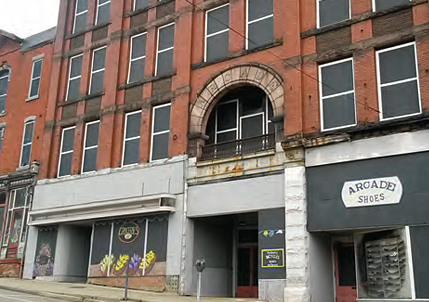
Artist Christopher Toepfer of The Neighborhood Foundation painted a brighter face on the historic Arcade Building in Jamestown, New York.
Photo courtesy: Christopher Toepfer
Vacant and abandoned properties are often easy to spot. The telltale signs of neglect — overgrown lawns, sagging gutters, and accumulating debris — can be a primary mechanism for the contagion or spillover of negative effects of vacant and abandoned properties.1 Even boarding up the windows and doors, the typical method of securing a vacant property, can turn the property into an eyesore and act as a visual reminder of its distress.
Several recent innovations attempt to shift these perceptions by taking advantage of alternatives to bare plywood. Even a simple coat of paint — an extra step and expense for those securing properties — can improve the appearance of a boarded door or window. The vacant property ordinance in Nashville, Tennessee, for example, requires that plywood be painted a color that matches the building.2 More elaborate paintings, such as those by Christopher Toepfer of The Neighborhood Foundation, add details such as windowpanes or flowers. Decals that appear to be functional doors and windows, such as those produced by the Michigan-based company Home Illusions, can make a house look occupied, at least from a distance.3
A company in Cleveland takes this approach a step further by replacing the unsightly plywood boards altogether. Clear plastic panels made from recycled materials offer the security of plywood and the appearance of glass with the added benefit of allowing police and other officials to look inside, thereby discouraging illegal activities.4
No research yet exists to measure the potential benefits of these cosmetic efforts. The slightest scrutiny of these facades betrays the underlying state of distress. Yet the camouflaging or replacement of plywood doors and windows might reduce the negative externalities often associated with vacant and abandoned properties, and, at the very least, make them look a little nicer.
- John P. Harding, Eric Rosenblatt, and Vincent W. Yao. 2009. “The Contagion Effect of Foreclosed Properties,” Journal of Urban Economics 66, 164–78.
- “Ordinance No. BL2007-40,” City of Nashville website (www.nashville.gov/mc/ordinances/term_2007_2011/bl2007_40.html). Accessed 4 February 2014.
- Conor Dougherty. 2013. “Decorative Details Disguise Boarded-Up Houses,” The Wall Street Journal, 21 November. Accessed 4 February 2014.
- Ibid.
Evidence Matters Home Next Article
|


